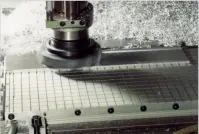Vacuum Workholding FAQ
Why do people use vacuum chucks?

Some parts are challenging to hold down with clamps, especially parts manufactured from flat sheets of metal or plastic. Clamps also get in the way of the cutter. So, a vacuum chuck can provide a great way to machine a part material without the worry of clamps blocking the cutting.
Can I Hold Any Part with Vacuum?
No. Vacuum works on a principle of applied force against the part material. So, the holding vertical force, created by atmospheric pressure, is based on the part area. A small part won’t generate a lot of holding force. A large part will generate a ton (literally!) of part holding force.Can I Hold a Small Part Using a Larger Industrial Vacuum Pump?
It does not work like that. On Earth, we have an atmosphere consisting of 14.7 pounds per square inch. A vacuum workholding pump will reduce that to nearly zero. So, when you have pressure above the part and vacuum below (via the chuck), you have a pressure differential of 14.7 psi on the part. Multiply the part area by that, and you get the vertical holding force. A vacuum pump, no matter the capacity (usually volume flow rate in CFM), cannot create a vacuum level greater than 14.7 PSI.Why Are There Larger Vacuum Pumps Available? What Purpose Do They Serve?
Vacuum workholding pumps are rated based on their ability to move a volume of air to create a vacuum. When a fixture or vacuum chuck is large (think big aircraft parts), there are typically leaks in the system. These leaks will reduce the overall vacuum level under the part and lower the holding force. So, the vacuum pump must be able to compensate for losses due to leaks. A perfectly sealed vacuum fixture can use a very small capacity vacuum pump. In the real world, things get dirty and worn and leak.How To Prevent the Chuck from Leaking?
It is impossible to produce an industrial vacuum fixture that can seal perfectly against the part material. So, we must use a compliant seal medium. The most common material used is O-Ring rubber. This sealing material is pressed down in a fixture slot, generally around the outside perimeter of the part. The seal will compress and prevent the vacuum from leaking. When worn, it can easily be replaced.Are There Limitations on a Vacuum Chuck?
Yes. A large, flat plate part is easy. Most parts are not that simple. They have holes drilled or windows that must be milled out. Vacuum chucks can be custom manufactured to support these features. The vacuum areas must be completely sealed, so it is not good to drill a hole in the middle of the part and break the seal. So, provisions can be made to expose sections of the part without losing the holding force. Some small parts are challenging to hold, as well.Is It Impossible to Hold Small Parts with Vacuum?
Not impossible, but it can be challenging. It depends very much on the size of the part and if it can be made from a larger sheet. A vacuum fixture can securely hold the larger sheet. Most machining can be done, leaving just some final cut-aways using careful techniques.How Do I Build a Vacuum Fixture?
You can design and fabricate your own vacuum fixture if you have the knowledge and a machine shop. You may also consider partnering with a vacuum specialist who can evaluate your part and recommend a suitable Witte-style vacuum pump and chuck design.Some chucks must be custom-made. However, there are also vacuum chucks available from stock that may work, depending upon the complexity of your part. Your part shape and accuracy requirement will determine the type of vacuum fixture you use.
Can I Use High-Pressure Flood Coolant with a Vacuum Fixture?
Yes. However, the problem you must anticipate is the coolant finding its way to the vacuum pump. As previously stated, all vacuum fixtures leak. This leakage will pull whatever is available into the system, including chips and flood coolant. The inclusion of chip-flooded coolant is not suitable for the vacuum pump. So, it is recommended to include a coolant separator system (filter or more complex liquid separation system) when using flood coolant.


